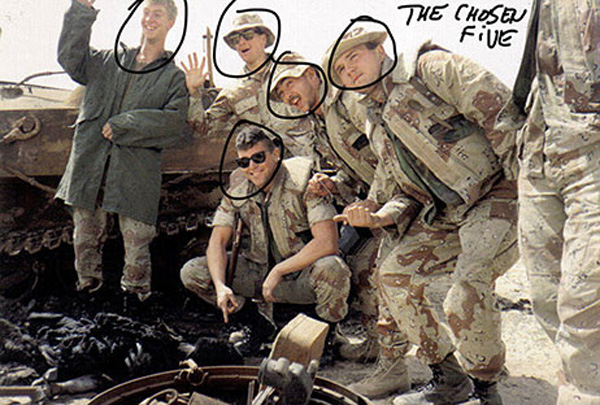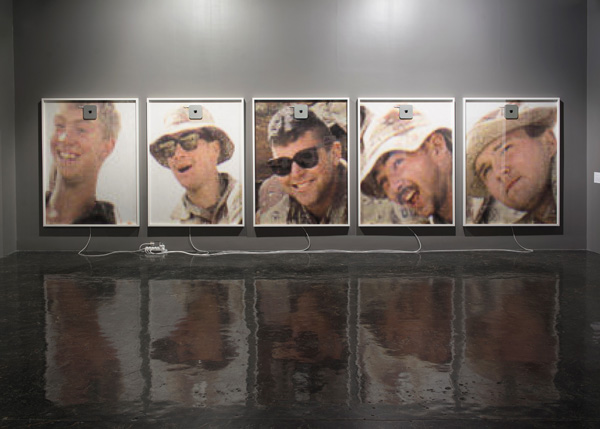Thomas Kvam is not one to shy away from controversy. His 22-minute animated film, Eurobeing (2006), shows an artist sporting an armband evocative of fascist attire, with the word “jihad” inscribed on his forehead. The painting he is working on at his easel is, as the fictional protagonist claims, “an invisible picture of Muhammad” (see Texas “Draw the Prophet” Contest is Shameless Muslim-Baiting, The Secret Islamic Devotional Art That Depicts Muhammad).
A more recent work by the Norwegian artist, The Chosen Five (2015), is centered on a picture of five American soldiers which shows the men posing, smiling, while pointing at a burnt corpse on the ground. The carbonized matter on the photo’s bottom left is hardly recognizable as human remains, but the faces of the five are clearly distinguishable. The artist now wants to use facial recognition software to find out who they are.
The piece is currently on view at the Kunstnernes Hus in Oslo, Norway as part of the exhibition “The Shadow of War: Political Art in Norway 1914–2014.” The digital search takes place throughout the show’s duration, until March 29. The artist enlarged each of the men’s faces to life-size dimensions. Biometric information of the soldiers’ facial features feeds back to a computer attached to each of the blown-up photographs, following a facial recognition search process that has now become standard practice in professional profiling.
“I’m letting the internet search for them,” Kvam continued. “When I find their social media profiles, I can identify them.” However, he doesn’t want to know the search results before the end of the exhibition. While this process could raise questions about the nature of public shaming, the artist has other things in mind for the so-called “chosen five”: “My intention is to locate them, then develop the next part of the project, and then confront them with the picture,” the Munich based artist told artnet News.
But exposing the soldiers’ identity is only partially the point of this work. Kvam utilizes the surveillance potential of social media and the internet the same way governments do. Considering the relative low impact Edward Snowden’s revelations on the NSA’s surveillance practices has had on the way we use the Internet, this reversal could inject some missing subversion into the matter, by demonstrating how individuals can use the same technology for political activism.
Kvam’s merging of art and activism also evokes relevant questions on the use of such images in the media—or rather, as he claims, the fallacy of the lack thereof. While ISIS releases videos of beheadings as propaganda, images such as the one he used never reach the public, due to what he refers to as “journalistic self-censorship,”—especially, as the artist stresses, considering the huge strain the leaking of the pictures from Abu Ghraib has been on American warfare.
But where did Kvam get the image in the first place? The photo, and thousands more, originated from a now-defunct website initiated by Chris Wilson in 2004 who, in a twisted claim of patriotism, gave access codes for his porn site to American troops deployed in Iraq and Afghanistan in exchange for pictures showing them in combat areas.

Thomas Kvam, The Chosen Five 2015.
Image courtesy the artist
The pictures uploaded there soon became increasingly disturbing, gory, and dehumanizing. The website was eventually removed from the internet in 2006 under obscenity law, and Wilson, arrested.
But the website’s name, nowthatsfuckedup.com, was rarely mentioned in any of the media coverage of the case, and mainstream media shied away from publishing the images. Indeed, very few potentially damaging images ever made it to the front page. “U.S soldiers used pictures of disfigured Iraqi corpses in exchange for pornography at the same time as photographs of flag-draped coffins of dead American soldiers were officially banned in American media,” He writes in an artist statement.
Kvam started downloading the website in 2005: “At that point, it comprised thousands of pictures and related blog entries, scattered over a particularly shambolic website, which turned my attempt to preserve nowthatsfuckedup.com for posterity into a limited, yet representative sample.”
In 2011, Kvam published the book nowthatsfuckedup/Krieg dem Kriege with collected documentation from the website. “This book is to my knowledge all that remains of the website—as a result, it is both archive and reference document,” he says.







